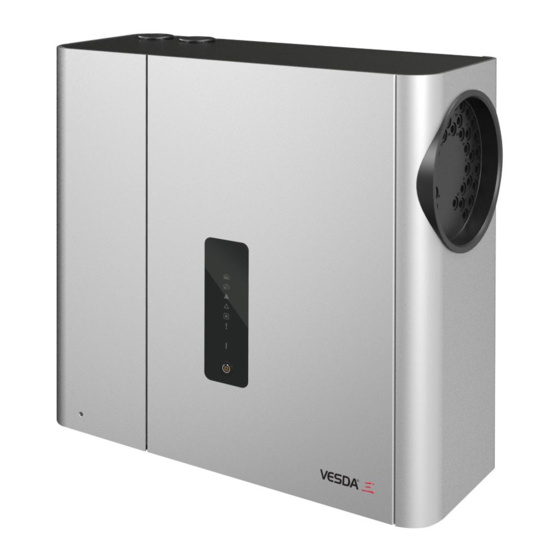Advertisement
Table of Contents
- 1 Table of Contents
- 2 Introduction to VESDA-E VEA Commissioning
- 3 The Commissioning Process
- 4 Pre-Commissioning (before Going to Site)
- 5 Pre-Commissioning (on Site)
- 6 Configuration
- 7 NFPA72 Code Compliance
- 8 NFPA72 Requirements
- 9 Commissioning Tests
- 10 Initial Tests
- 11 Functional Tests
- 12 Smoke Tests
- 13 Walk Test
- 14 Annex A: VESDA-E VEA Configuration Record
- 15 Annex B: VESDA-E VEA Commissioning Form
- Download this manual
Advertisement
Table of Contents

Summary of Contents for VESDA VESDA-E VEA
- Page 1 VESDA-E VEA Commissioning Guide October 2019 Document no.: 32407_01 Part no.: 30758...
- Page 2 Commissioning Guide VESDA-E VEA Intellectual Property and Copyright This document includes registered and unregistered trademarks. All trademarks displayed are the trademarks of their respective owners. Your use of this document does not constitute or create a licence or any other right to use the name and/or trademark and/or label.
- Page 3 This VESDA product incorporates a laser device and is classified as a Class 1 laser product that complies with FDA regulations 21 CFR 1040.10. The laser is housed in a sealed detector chamber and contains no serviceable parts. The laser emits invisible light and can be hazardous if viewed with the naked eye.
- Page 4 To commission the VESDA-E VEA detector, you must have the necessary certification issued by Xtralis or an authorized distributor. Commissioning before you receive the appropriate training may void the warranty.
-
Page 5: Table Of Contents
NFPA72 Requirements ....................... 4 Commissioning Tests ........................... 5 Initial Tests ..........................5 Functional Tests .......................... 6 Smoke Tests ..........................6 Walk Test............................7 Annex A: VESDA-E VEA Configuration Record ................... 8 Annex B: VESDA-E VEA Commissioning Form ..................10 32407_01... -
Page 6: Introduction To Vesda-E Vea Commissioning
The objective and outcome of the commissioning process is to provide a fully functional VESDA- E VEA detector that matches local code requirements and customer specification. -
Page 7: The Commissioning Process
The commissioning process is a step-by-step process designed to systematically check and validate all the operational aspects of the VESDA-E VEA detector. The process benchmarks the performance levels tailored for each site and generates the necessary documentation for the effective management and maintenance of the detector. -
Page 8: Configuration
Note: Make sure to click the Apply button to save the configuration into the VEA detector. To record the detector's configuration either print it using VSC or record in Annex A: VESDA-E VEA Configuration Record. To print the configuration, select the detector on VSC tree view at left and choose the Print command on the File menu. -
Page 9: Nfpa72 Code Compliance
NFPA72 Code Compliance NFPA72 Requirements VESDA-E VEA is classified as an Aspirating Smoke Detection (ASD) product and it complies with NFPA72 Initial Acceptance and Annual testing requirements with minimal testing. With full supervision and automated centralized tests, VEA verifies end to end system operation continuously and automatically performs system integrity tests at set times and at much shorter intervals than the annual period required by NFPA72. -
Page 10: Commissioning Tests
Commissioning Guide VESDA-E VEA Commissioning Tests Initial Tests 1. Run a Flow Scan to the detector. Select the detector, right click it then select Device and click Start Flow Scan Base. This process might take 35 minutes. 2. Generate a log file with all the available data. Check the airflow values in the event log for each tube as shown in the example below. -
Page 11: Functional Tests
4. Record results in the commissioning forms Smoke Tests Smoke tests are required to meet the local codes and standards requirement, how VESDA-E VEA meets the NFPA 72 requirements is described in section 4 of this document. 1. Perform the local smoke test using Start Local Smoke Test command and then complete the test using "Stop Local Smoke Test"... -
Page 12: Walk Test
This step satisfies NFPA 72 smoke test requirement of testing longest tube on an ASD system. It is not necessary to test every sampling point for smoke test as explained in section 3. Ensure that the transport time is within the limits specified in VESDA-E VEA Installation Sheet (Document # 27679), reproduced below: Transport time is determined by the length of the microbore tubes used on the detector. -
Page 13: Annex A: Vesda-E Vea Configuration Record
VESDA-E VEA Commissioning Guide Annex A: VESDA-E VEA Configuration Record General Tab Air Flow Tab Fault Sensitivity Network Name Flow Fault Delay Location Time of Day of Flow Serial Number Scan Address (VESDAnet Flow Scan Zone) Sampling Point Test VESDAnet Tab... - Page 14 Commissioning Guide VESDA-E VEA Tube Tab (TN = Tube Number, GF = Group Factor) Tube Name Tube Name 32407_01...
-
Page 15: Annex B: Vesda-E Vea Commissioning Form
VESDA-E VEA Commissioning Guide Annex B: VESDA-E VEA Commissioning Form Customer Name Site Name and Address Installer (Name & Contact) Commissioning Engineer (Name & Contact) Commissioner / AHJ (Name & Contact) Commissioning Checks Done (Y/N) Notes Correct maximum tube length configured... - Page 16 Commissioning Guide VESDA-E VEA Sampling points tested using Xtralis VSC Sampling Point tests command Tubes 1 to 40 sampling points tested Tubes 41 to 80 sampling points tested Tubes 81 to 120 sampling points tested Smoke tests done Smoke Type used:...
- Page 17 VESDA-E VEA Commissioning Guide www.xtralis.com UK and Europe +44 1442 242 330 The Americas +1 800 229 4434 Middle East +962 6 588 5622 Asia +86 10 56697101 Australia and New Zealand +61 3 9936 7000 A Disclaimer about this document, statements about Intellectual Property, Copyrights, and Liability, as well as a General Warning are available in an earlier section of this document.





Need help?
Do you have a question about the VESDA-E VEA and is the answer not in the manual?
Questions and answers